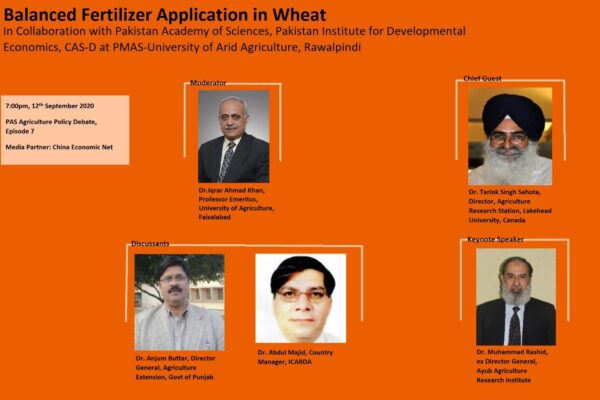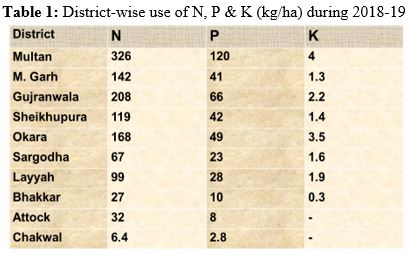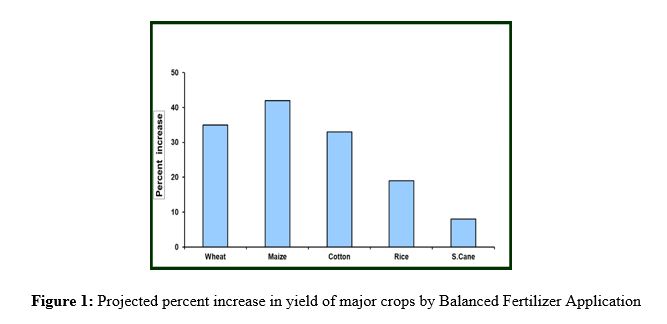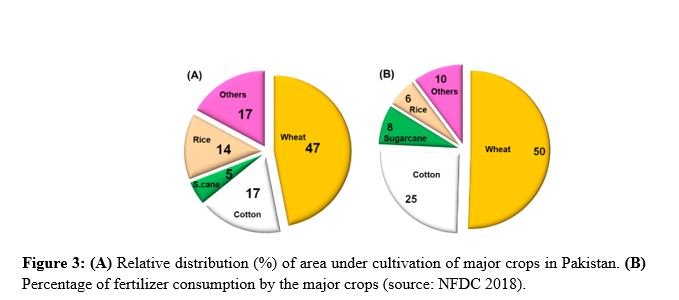PAS Agriculture webinar episode 7 entitled “Balanced Fertilizer Application in Wheat/Policy Brief”

PAS Agriculture Policy Debate, Episode # 7
Prof. Dr. Iqrar A. Khan in collaboration with Pakistan Academy of Sciences (PAS), Pakistan Institute for Developmental Economics and CAS-D at PMAS-University of Arid Agriculture, Rawalpindi organized a zoom PAS Agriculture webinar episode 7 entitled “Balanced Fertilizer Application in Wheat” on 12th, September 2020 at 07:00 PM PST.
Executive Summary
Crop yields are a function of combination of factors i.e. genetics, soil, water, climate and application of technologies. Balanced application of fertilizer has become to be known as a major cost and performance determinant in crop production. High cropping intensity coupled with a lack of proper rotation and non-judicious application of nitrogenous (Urea) fertilizer has made soils non-responsive to additional inputs. Our fertilizer industry had been growing on the availability of natural gas as a raw material for urea manufacturing while the other essential elements were ignored. The farmer is also ill informed on the perils of excessive use of a single nutrient. With experience, the farmer learns to add Phosphatic fertilizer as well. Whereas balancing the application with Potash and other macro- and micro-nutrients is still a far cry and at times the costs are prohibitive.
Wheat is a crop covering half of the cultivated area during Rabi season (>21 million acres). It consumes a half of the total fertilizer sold in Pakistan, dominated by Nitrogen. The stagnant wheat yields, and escalating cost of production are a serious concern where cost of fertilizer is significant. The lack of balance in fertilizer application compromises the yields and results in low fertilizer use efficiency. There is an immense environmental cost associated with excessive Nitrogen use.
Soil and water analysis are the key elements in determining right dose and combination of fertilizer elements. The public laboratories for soil and water analysis have been in place and large data sets are available for analysis and applications. Through a series of projects undertaken at the University of Agriculture, Faisalabad, we were able to develop a fertilizer prediction model. It was felt that the data needs to be improved and expanded. The Punjab Government launched a huge soil and water analysis project by title of Extension 2.o. The sampling design has been made representative and number of samples has been raised many folds. These data are yet to be analyzed and made part of the fertilizer prediction model. Simultaneously, FFC has a network of field labs offering free soil and water analysis service. The field wing of FFC developed Apps to offer such services.
This webinar was designed as a continuation of debate on wheat crop productivity as a challenge. Earlier sessions have revealed that we have varieties with a potential to double the yields and there can be a gain of up to 20% by improving the seed quality and seed treatments. Here, we will find out potential for yield improvement by promoting balanced use of fertilizer applications. The aim is to share the available knowledge and services for a better wheat crop in the next season. We were joined by a very senior wheat agronomist from Canada who made his concluding remarks on the reasons for a record wheat year in Canada while here we have been facing stagnation for years.
As a summary of the event, following pathways were identified as strategic policy outline for improving the wheat yields with balanced fertilizer applications:
- The horizontal soil variability, diverse climates and cropping systems are not amenable to a uniform fertilizer application regime. The stagnation of wheat yields can be effectively broken by a balanced fertilizer application based on site-specific soil analyses.
- The soil analyses and crop yield data provided by the Soil Fertility Research Institute was substantial to develop a model but not a representative enough to be considered as a universal model. The ongoing Extension 2.o would generate sufficient data to enable the farmers to use the existing models at large scale.
- The R&D projects carried out at the University of Agriculture, Faisalabad have generated stakeholders and users support to expand the ICT driven balanced fertilizer prescription service.
- The outreach work as farmers days and through press and social media has received convincing response to show the keen interest that farmer takes in the adaptation of new information and technologies as long as they are accessible and affordable.
- The public R&D output needs to be complimented and adapted by the industry and business.
- FFC has created a parallel service and outreach system to promote balanced application of fertilizer elements. Collaboration between government, industry and academia would promote the balanced use of fertilizer for improved FUE and better crop yields.
- The balanced use of fertilizer would also enhance our compliance to SDGs.
- Evidence from Canada, good management practices e.g. maintenance of soil fertility and high organic matter contents (generally regarded as Integrated Nutrient Management) are regarded as key components of Balanced Fertilizer Use, thereby enabling better resilience of crops against climate adversities.
Opening Remarks/Welcome Address
Dr. Iqrar Ahmad Khan, Professor Emeritus, University of Agriculture, Faisalabad opened the PAS Agriculture Webinar, Episode 7 online session by welcoming the keynote speakers and participants, and presented an overview of meetings’ agenda.
Balanced Use of Fertilizer for Wheat
Dr. Muhammad Rashid, former Director General AARI, presented his project results based on data gathered from government laboratories for soil and water analysis. While reviewing the current status of fertilizers’ use across the Punjab province, he showed the extreme predominance in use of N over P and great variation in use of fertilizers in various districts ranging from 6 kg/h & 3 kg/h in Chakwal to 326 kg/h & 120 kg/h in Multan of N and P respectively (Table 1). To overcome this situation, UAF developed soil test-based fertilizer prediction models to predict amount of N and P for desired yield of specific crop in any field (http://fertilizeruaf.pk/User/Prediction.aspx). Dr. Rashid presented the details of model development, validation, awareness through electronic and print media and adoption in the field. Website visits and calls at the call center were used as indicators for the response of farmers in addition to farmers field days, surveys and farmers’ meetings. SMS service was found most useful tool for sending the message to the farmers.
Dr. Rashid stated that promotion of Balanced Fertilizer Use across the Punjab province is estimated to cause significant increase in yield of major crops viz. wheat, cotton, maize, rice and sugarcane etc. (Figure 1). On the basis of calculations made at National Fertilizer Development Center, that by balanced use of fertilizers even on 50% area of the Punjab can save Rs. 350 billion in one year. According to the survey conducted by Dr. Rashid and his staff in three selected villages, the farmers saved Rs. 2000 to Rs. 3000 per acre in fertilizers by applying the fertilizers in accordance with the fertilizer prediction models for getting the same yield with their traditional use of fertilizers. Thus, the economics of the model is highly favorable both for the farmers and the economy of the country.
ICARDA support for UAF-developed Fertilizer Prediction Model
Dr. Abdul Majeed, Consultant-Pakistan Country Manager, ICARDA explained the involvement of his organization in the expansion of UAF-developed fertilizer prediction model for the promotion of balanced use of fertilizer application. During the project period, it was pointed out that 65% farmers (particularly those with small landholdings) had inadequate information and/or resources to visit the soil testing laboratory and get the pre-sowing analysis done. To facilitate these farmers, the concept of Agri. Service Providers (ASP) was initially introduced in four selected districts i.e. Vehari, Gujranwala, Sheikhupura and Narowal. Youth were trained in those districts (e.g. empowering soil sampling skills and contacting Govt. labs), to provide the services to the farmers at their door step at nominal cost. In this context, 200 farmers were provided soil testing facility, covering a vast area of ~17000 acres with great success. Based on the overwhelming response received, he stated that ICARDA has now implemented this concept of ASPs across several districts of Punjab, whereby ~70 personnel are actively working to disseminate latest agricultural technology (in addition to soil testing facility) to the farming community. He hoped that the portfolio of ASP entrepreneur model will expand in future and continue playing a significant role to increase the per acre yield and economic returns of the farmers.
Soil Fertility Status & Fertilizer Use Trend in Pakistan
Mr. Tariq Javid represented FFC and explained the work of his company in promotion of balanced use of fertilizer. In this context, FFC since its inception is providing free soil & water analyses facility to the farmers across the country. Currently, FFC has established five soil & water testing laboratories that are located at Hyderabad, RYK, Multan, Sheikhupura and Sargodha – engaging a widespread team of Agri. experts who provide free soil testing as well as crop specific advisory services to the farmers at their doorstep. In this regard, about 0.1 million farmers have been contacted so far and provided free soil analysis facility for macro- (e.g. N, P & K) as well as micro-nutrients such as Zn & B etc. Based on the analysis results of FFC laboratories (~0.5 million soil samples analyzed so far), it is found that almost all of the soils of Pakistan are deficient in organic matter and available P. Potash (K) has been found deficient in ~50% soils of the country. Micronutrient deficiency is also a wide-spread plant nutritional problem affecting Pakistani agriculture. Approximately, 85% or even more of fields under many crops (including cotton, wheat, sugarcane, maize, sorghum, rapeseed-mustard, peanut) are affected by Zn deficiency. This could also be confirmed from unpublished data of FFC Farm Advisory Laboratories where more than 14,000 soils samples have been analyzed since 2004. The results of FFC labs suggest that B deficiency in soils is about 60% (Figure 2). Contrarily, an overview of fertilizer usage trend in Pakistan over the last four decades demonstrated an exponential increase in Nitrogen-based fertilizers, however consumption of phosphatic fertilizers is considerably low. Likewise, K fertilization of crops is largely ignored despite its increasing deficiency in soils across the country. While advocating the significance of soil testing based Balanced Fertilizer Use to increase crop productivity, Mr. Tariq Javid also emphasized the application of micro-nutrients (particularly Zn & B) that has been reported to cause plant as well as human health consequences (Figure 2).
 hand side, an historical view of fertilizer usage trend (N, P & K) in Pakistan is shown over the last four decades (source: FAOSTAT, 2019).
hand side, an historical view of fertilizer usage trend (N, P & K) in Pakistan is shown over the last four decades (source: FAOSTAT, 2019).
Wheat is a dietary staple, covering almost 47% cultivated area of the country, also demonstrating 50% of the total fertilizer consumption (Figure 3). During the last several years, wheat yield has seen a severe decline, reaching 50% of the potential yield targets of most of the cultivated wheat varieties. Balanced fertilizer use contributes up to 50% to the crop productivity, hence, there is a dire need to create awareness among the farming community to formulate soil testing-based fertilizer recommendations. He introduced toll free number and mobile Apps to encourage farmers to avail FFC free sampling and analysis service.
Use of Nanotechnology in Fertilizers to Enhance Crop Productivity
Dr. Noor Muhammad Butt, Chairman & Professor of Nanotechnology at Preston Institute of Nano Science and Technology, explained the development of nano fertilizers and nano applications. Nanomaterials are reported to enhance crop productivity by efficiently regulating the nutrients’ delivery to plants and targeted sites, thereby minimize the wastage and ultimately usage of agrochemicals (Trenkel, 2010). In conventional agriculture, excessive fertilizer application to the crops is practiced directly into the soil or sprayed on the leaves, which surpass the nutritional need of the plant. This is because a very low percentage of fertilizer reaches its target site, due to volatilization, leaching of chemicals, run-off losses, and microbial or photolytic degradation (Shang et al., 2019). This excess of chemical fertilizer causes contamination of water reservoirs, also negatively affecting the nutrient equilibrium of the soil (Khan et al., 2018). Nanomaterials can enhance crop productivity by improving fertilizer nutrient availability in soil and their subsequent uptake by plants. Furthermore, reduced size of nanomaterials is reported to facilitate an increase in the surface mass ratio of particles, thereby enables the absorption of abundant nutrient ions that is later desorbed slowly and steadily for an extended period (Prasad et al., 2017). Therefore, formulations of nano fertilizers can provide balanced nutrition for crops throughout the growth cycle, which in turn improves agricultural production.
Record Bumper Harvest of Wheat Crop in Canada: Lessons to Learn
Dr. Tarlok Singh Sahota shared his work experience with wheat farmers in Canada. Canada grows both Spring and Winter wheat of soft and hard categories (Collier et al., 2020). He spoke about the major reasons behind record wheat yield harvest reported in Canada that included: (i) Favorable temperate climate of Canada for wheat cultivation; (ii) Existence of strong breeding system that involves both public & private institutions, ensuring regular release of climate-resilient high yielding wheat varieties; and (iii) Good management practices e.g. soil testing. He stated that soil analysis is a regular feature being practiced by most of the Canadian farmers and for allowing fertilizer applications only as required and in a combination that suits a particular soil analysis. He spoke about certified crop advisors who can arrange soil & water analysis and offer prescriptions for a balanced fertilizer application. As an example, he talked about the Nitrogen fertilization of crops that is generally now being suggested by the certified crop advisors to be fulfilled by a blend of Ammonium Sulfate (AS), Urea and Polymer-coated urea. Based on the experiments conducted, it offers multiple advantages e.g. slow release of N (in NH4 form) from AS and polymer-coated urea, and supplementation of sulfur via AS source of nitrogen. Since temperate climate of Canada delays N release from its sources like polymer-coated urea, therefore its blend with Urea is recommended to farmers (Sahota, 2014). Talking about general recommendation of 2:1:0.5 for N:P:K i.e. routinely being practiced in Pakistan, he disagreed with this recipe based on experimental findings of his work on wheat crop. In this study, macro- and micro-nutrients removal by wheat and other forage crops is appended below as supplementary information (Sahota et al., 2014). Herein, he highlighted the inclusion of 6 nutrients (macro-elements; N, P, K, S & micro-elements; Zn & B) as a routine practice for Balanced Fertilizer Use in Canada. Talking about other factors reported favorable for wheat growth and productivity in Canada, he reported high soil organic matter contents (up to 4-6%) caused by temperate climate. He also regarded crop rotation e.g. wheat-canola etc. (unlike wheat-rice in sub-continent) as another reason behind better wheat performance in Canada. Altogether, he summarized good genetics and better management practices as the major causes of consistent and even increasing wheat yield trends in Canada.
Panel Discussion
Dr. Manzoor Soomro, Chairman & Founder of ECO Science Foundation, advocated the training and capacity building needs of the farmers. For the continued and far reaching impact of the fertilizer prediction model project launched by UAF, he emphasized to increase the number of outreach activities for the knowledge dissemination and skill development of local farming community.
Dr. Asif Kamran, Agriculture Economist, NIAB appreciated the “Fertilizer Prediction Model” as an excellent concept to predict yield from given level of fertilizer and vice versa. He suggested to include two more modules in the models namely Economy and Environment Module. The economy module should guide farmers about profit calculation based on fertilizers price and price of the produce. The Environment module should guide farmers to address SDG12 i.e. Responsible consumption and production, and let the farmers know about emissions per unit of output.
Dr. Muhammad Ansar Farooq, Soil Chemist, FFC Multan apprised the participants regarding free soil & water analysis facility of FFC for the farming community throughout the country. He stated that farmers can call on FFC Kashtkar desk (0800-00332, a toll-free number) to avail this service, hence promote the concept of Balanced Fertilizer Use to increase per acre yield and economic returns.
References
Collier, G.R.S., D.M. Spaner, R.J. Graf, and B.L. Beres. 2020. The Integration of Spring and Winter Wheat Genetics with Agronomy for Ultra-Early Planting into Cold Soils. Front. Plant Sci. 11: 89.
FAOSTAT. 2019. Statistics Division (Rome: Food and Agriculture Organization of the United Nations) (www.fao.org/faostat/en/#data)
Khan M.N., Mobin M., Abbas Z.K. and Alamri S.A. (2018) Fertilizers and Their Contaminants in Soils, Surface and Groundwater. In: Dominick A. DellaSala, and Michael I. Goldstein (eds.) The Encyclopedia of the Anthropocene, vol. 5, p. 225-240. Oxford: Elsevier.
NFDC. 2018. Crop-wise usage of Fertilizer, National Fertilizer Development Centre (NFDC), Planning and Development Division. Islamabad.
Sahota, T.S., L. Limin, and T. Blaine. 2014. TBARS Annual Report 2014. Pages 17-21.
Sahota, T.S. 2014. Use Blends of N Fertilizers for Higher Economic Returns. Ontario Farmer. 48(1): B3.
Shang, Y., M.K. Hasan, G.J. Ahammed, M. Li, H. Yin, and J. Zhou. 2019. Applications of Nanotechnology in Plant Growth and Crop Protection: A Review. Molecules. 24(14): 2558.
Prasad, R., A. Bhattacharyya, and Q.D. Nguyen. Front. Microbiol.8: 1014.
Trenkel, M.E. 2010. Slow- and Controlled-Release and Stabilized Fertilizers: An Option for Enhancing Nutrient Efficiency in Agriculture. 2nd Edition, IFA, Paris, France.
Acknowledgements
- Pakistan Academy of Sciences
- University of Agriculture, Faisalabad
- PMAS Arid Agriculture University, Rawalpindi
- Lakehead University, Canada
- Fauji Fertilizer Company Limited
- International Center for Agricultural Research in the Dry Areas (ICARDA)
Web services were provided by Mr. Shehzad Ashraf and Mr. Muhammad Naseer. Webinar design, illustrations, announcements, registration, feedback and analysis, and editorial assistance by Mr. Nehal Ahmad Khan.
Supplementary Information
The audio/video recording of the event is available at the webpage of PAS www.paspk.org and at the YouTube link: https://youtu.be/xjBD37-cWds



